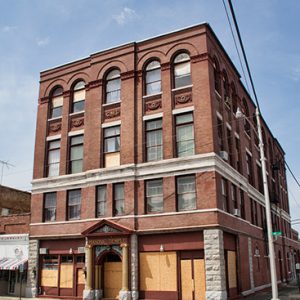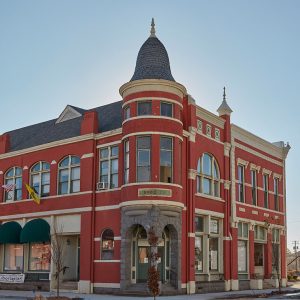calsfoundation@cals.org
Pine Bluff Commercial Historic District
The Pine Bluff Commercial Historic District in downtown Pine Bluff (Jefferson County) includes 141 properties within its boundaries with eighty-four deemed to be contributing. Historic properties within the period of significance in the district date from 1850 to 1958. The district was added to the National Register of Historic Places on May 20, 2008; five properties within the district are separately listed on the National Register.
Centered on Main Street, the district roughly extends from Barraque Street on the northern edge to 10th Avenue to the south. The eastern border is near Alabama Street, and the western is along Walnut Street.
Economic development in the boundaries of the historic district began shortly after statehood in 1836. Located near the Arkansas River, Pine Bluff became a stop for steamboats on the river. Following the Civil War, rail access helped make the city an economic powerhouse as the population increased from just over 2,000 in 1870 to just over 44,000 in 1960. Much of the commercial development centered on the area included in the district.
The oldest structure in the district is the home of Dexter Harding, which was originally constructed in 1850 north of downtown Pine Bluff. It was moved to its current location in 1969.
Many of the buildings in the district date from 1880 to 1910. The buildings include a number of different architectural styles. Located at 223 and 225 West Barraque Street, the two-story R. M. Knox Building includes Italianate features. The 1883 Dellmon and McGregor Hardware building across the street is constructed with Tudor details. The 1906 People’s Bank Building on 2nd Avenue includes Classical Revival details. The single-story building is fronted by granite columns, and tiles at the main entrance spell “Peoples Bank.”
Constructed in nineteenth- and early twentieth-century American movement commercial style, the building at 301 West Barraque Street housed a feed and grain store for years before serving a frozen food business. The single-story building was constructed in 1894 and includes two additions. Noted architect Charles Thompson designed the Bridges Building located at 500-502 Main Street. The two-story brick building is topped with a flat roof and large eaves supported by large brackets. An entrance at the rear of the building along 5th Avenue is topped with a pediment inscribed “BRIDGES.” Originally constructed as the Postal Telegraph & Cable Building in 1929, the structure at 108 West 2nd Avenue is a two-story brick building with stucco present on the exterior.
Individually listed properties in the district include the Pines Hotel, Masonic Temple, Community Theater, Union Station, and Merchants and Planters Bank. At the time of the nomination of the district to the National Register, several of the buildings had been gutted, with only exterior walls still standing. Others had been removed completely, leaving only empty lots or parking areas.
The district is a good example of late nineteenth- and early twentieth-century commercial buildings. The history of Pine Bluff and much of southeastern Arkansas can be traced through the structures in the district, helping visitors understand the way the city has evolved over the decades.
For additional information:
Bearden, Russell E. “Pine Bluff’s Golden Era: 1890–1920.” Jefferson County Arts and Science Center Publication (July 2004): 6.
“Pine Bluff Commercial Historic District.” National Register of Historic Places registration form. On file at Arkansas Historic Preservation Office, Little Rock, Arkansas. Online at https://www.arkansasheritage.com/docs/default-source/national-registry/JE0907-pdf (accessed November 1, 2023).
Leslie, James W. Pine Bluff and Jefferson County: A Pictorial History. Virginia Beach, VA: The Donning Company, 1981.
“Walks through History: Pine Bluff Commercial Historic District.” Arkansas Historic Preservation Program. https://www.arkansasheritage.com/docs/default-source/ahpp-documents/sandwiching-tour-scripts/pine-bluff-chd-tour-script-2013768cce17-39ea-4bb8-b653-50019f3343e3.pdf?sfvrsn=866a204e_ (accessed November 1, 2023).
David Sesser
Southeastern Louisiana University
 Historic Preservation
Historic Preservation Dexter Harding House
Dexter Harding House  Masonic Temple
Masonic Temple  Merchants and Planters Bank
Merchants and Planters Bank 




Comments
No comments on this entry yet.